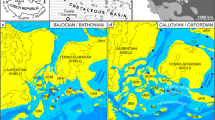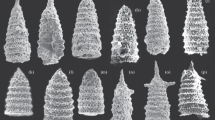Abstract
Fine-grained calcareous sediments often contain mass occurrences of well-preserved micro- and nannofossils, providing a wide range for biodiversity studies and enable to establish index-fossils. In our research, we depicted very tiny nannofossils which might be easily overlooked. Two new species Hymenomonas kelleri (calcareous nannoplankton) and Scrippsiella francofurtana (dinoflagellate, calcareous resting stage) are described, representing ecologically important forms. Their stratigraphic occurrence is documented from the lower part of the Frankfurt Formation (Miocene, Upper Hydrobia Beds). The collected sediment samples were taken from the temporary excavation site “WestendDuo” tower in the city of Frankfurt/Main, Germany. Both extremely small species show exceptionally fine structures and only slight signs of diagenesis. Their association with remains of further dinoflagellates and other species of algae (S. francofurtana together with a mass occurrence of the calcareous nannoplankton species Coccolithus pelagicus) as well as stromatoliths, shells of gastropods (Hydrobia species) and skeletons of fishes (Gobius species) gives hints to a highly diversed former biocoenosis and to a characteristic Miocene thanatocoenosis. Furthermore, a new mass occurrence of nannoplankton named layer +21 is described.









Similar content being viewed by others
References
Amann, P., Best, G., & Schneider, W. (1976). Bodenmechanische und geologisch-sedimentpetrographische Ergebnisse einer 100 m tiefen Kernbohrung im Untermiozän von Frankfurt am Main. Geologisches Jahrbuch, C16, 23–68.
Balech, E. (1959). Two new genera of dinoflagellates from California. Biological Bulletin, 116(2), 195–203.
Best, G. (1975). Feinstratigraphie der Hydrobien-Schichten (Untermiozän, Mainzer Becken). Mainzer Geowissenschaftliche Mitteilungen, 4, 75–138.
Best, G., & Müller, C. (1972). Nannoplankton-Lagen im Unter-Miozän von Frankfurt am Main. Senckenbergiana lethaea, 53(1/2), 103–107.
Best, G., & Schneider, W. (1974). Petrographische Untersuchungen an untermiozänen Karbonatgesteinen des östlichen Mainzer Beckens (Frankfurt a.M.) Neues Jahrbuch für Geologie und Paläontologie, Abhandlungen, 144(3), 271–295.
Braarud, T. (1954). Coccolith morphology and taxonomic position of Hymenomonas roseola Stein and Syracosphaera Carterae Braarud & Fagerland. Nytt Magasin for Botanik, 3, 1–4.
Conrad, W. (1928). Sur les Coccolithophoracées d'eau douce. Archiv für Protistenkunde, 63, 58–66.
Dale, B. (1977). New observations on Peridinium faeronse Paulsen (1905), and classification of small orthoperidinioid dinoflagellates. British Phycological Journal, 12(3), 241–253.
Demetrescu, E. (1999). The chlorococcalean alga Botryococcus and its significance in hydrocarbon exploration. Geo-Eco-Marina, 4(1999), 155–160.
Entz, G. (1883). Die Flagellaten der Kochsalzteiche zu Torda und Szamosfalva. Természetrajzi Füzetek (Naturhistorische Hefte), 7, 139–168.
Fischer, K. (1913). Urgeschichte und Geschichte des Geländes um das Museum der Senckenbergischen naturforschenden Gesellschaft an der Viktoria-Allee zu Frankfurt a. M. Jahresberichte und Mitteilungen des oberrheinischen geologischen Vereins. Neue Folge, 3(1), 40–47.
Fütterer, D. (1978). Distribution of calcareous dinoflagellates in cenozoic sediments of site 366, eastern North Atlantic. Initial Report of the Deep Sea Drilling Project, 41, 709–737.
Gaarder, K. R., & Heimdal, B. R. (1973). Light and scanning electron microscope observations on Rhabdothorax regale (Gaarder) Gaarder nov. comb. Norwegian Journal of Botany, 20(2–3), 89–97.
Gayral, P., & Fresnel, J. (1976). Nouvelles observations sur deux Coccolithophoracées marines: Cricosphaera roscoffensis (P. Dangeard) comb. nov. et Hymenomonas globosa (F. Magne) comb. nov. Phycologia, 15(3/4), 339–355.
Gao, X., & Dodge, J. D. (1991). The taxonomy and ultrastructure of a marine dinoflagellate, Scrippsiella minima sp. nov. British Phycological Journal, 26, 21–31.
Hottenrott, M. (1993). Mikrofloristische Gliederung und Charakterisierung der Tertiärschichten von Frankfurt a.M. In: Kümmerle, E. & Seidenschwann, G. mit Beiträgen von Blum, R., Ehrenberg, K.-H., Golwer, A., Hottenrott, M., Müller, K.-H., Rosenberg, F., Sabel, K.-J., & Wiegand, K.: Erläuterungen zur Geologischen Karte von Hessen 1:25000, Bl. 5818 Frankfurt a.M. Ost, 54–69, 307.
Janofske, D. (2000). Scrippsiella trochoidea and Scrippsiella regalis, nov. comb. (Peridiniales, Dinophyceae): a comparison. Journal of Phycology, 36, 178–189.
Kamptner, E. (1928). Uber eine Coccolithophoride aus der Alten Donau bei Wien, nebst einigen systematischen Bemerkungen. Archiv für Protistenkunde, 61, 38–44.
Kamptner, E. (1930). Die Kalkflagellaten des Süßwassers und ihre Beziehungen zu jenen des Brackwassers und des Meeres. Internationale Revue der Gesamten Hydrobiologie und Hydrographie, 24, 147–163.
Kamptner, E. (1937). Über Dauersporen bei marinen Coccolithineen. Sitzungsberichte der Akademie der Wissenschaften Wien, mathematisch-naturwissenschaftliche Klasse. Abteilung I, 146, 67–77.
Kamptner, E. (1958). Betrachtung zur Systematik der Kalkflagellaten nebst Versuch einer neuen Gruppierung der Chrysomonadales. Archiv für Protistenkunde, 103(1/2), 54–116.
Keupp, H. (1987). Die kalkigen Dinoflagellatenzysten des Mittelalb bis Untercenoman von Escalles/Boulonnais (N-Frankreich). Facies, 16, 37–88.
Keupp, H., & Mutterlose, J. (1994). Calcareous phytoplankton from the Barremian/Aptian boundary interval in NW Germany. Cretaceous Research, 15(6), 739–763.
Klebs, G. (1893). Flagellatenstudien. Zeitschrift für Wissenschaftliche Zoologie, 55, Teil 1: 265–351, Teil 2: 353-445.
Kohring, R. (1997). Calcareous dinoflagellate cysts from the Blue Clay formation (Serravallien, Late Miocene) of the Maltese islands. Neues Jahrbuch für Geologie und Paläontologie, Monatshefte, 1997(3), 151–164.
Kohring, R., Gottschling, M., & Keupp, H. (2005). Examples for character traits and paleoecological significance of calcareous dinoflagellates. Paläontologische Zeitschrift, 79(1), 79–91.
Kretschmann, J., Zinssmeister, C., & Gottschling, M. (2014). Taxonomic clarification of the dinophyte Rhabdosphaera erinaceus Kamptner, ≡ Scrippsiella erinaceus comb. nov. (Thoracosphaeraceae, Peridiniales). Systematics and Biodiversity, 12(4), 393–404.
Kretschmann, J., Elbrächter, M., Zinssmeister, C., Soehner, S., Kirsch, M., Kusber, W.-H., & Gottschling, M. (2015). Taxonomic clarification of the dinophyte Peridinium acuminatum Ehrenb.,≡ Scrippsiella acuminata, comb. nov. (Thoracosphaeraceae, Peridinales). Phytotaxa, 220(3), 239–256.
Kümmerle, E. (1974). Geologische Ergebnisse neuerer Bohrungen in Frankfurt am Main. Notizblatt des Hessischen Landesamts für Bodenforschung, 102, 143–158.
Lemmermann, E. (1907-10). Kryptogamenflora der Mark Brandenburg und angrenzender Gebiete, 3. Bd., Algen I (Schizophyceen, Flagellaten, Peridineen), 3. Klasse. Peridinales (pp. 563–712) Leipzig: Verlag von Gebrüder Borntraeger.
Loeblich III, A. R. (1965). Dinoflagellate nomenclature. Taxon, 14, 15–18.
Martini, E. (1981). Sciaeniden (Pisces) aus dem Basisbereich der Hydrobien-Schichten des Oberrheingrabens, des Mainzer und des Hanauer Beckens (Miozän). Senckenbergiana lethaea, 62(2/6), 93–123.
Martini, E. (1987). Nannoplankton aus den Oberen Hydrobien-Schichten des Hanauer Beckens (Miozän). Geologisches Jahrbuch Hessen, 115, 217–226.
Martini, E. (1988). Nannoplankton-Massenvorkommen in den Corbicula- (= Schichten mit Hydrobia inflata) und Hydrobien-Schichten des Oberrheingrabens, des Mainzer und des Hanauer Beckens (Miozän). Geologisches Jahrbuch, A110, 205–227.
Martini, E. (1990). The Rhinegraben system, a connection between northern and southern seas in the European Tertiary. Veröffentlichungen aus dem Übersee-Museum, A10, 83–98, 208–211.
Martini, E., Ott, W., & Keller, M. (2004). Der Grenzbereich Untere/Obere Hydrobien-Schichten – ein neuer Aufschluss in Frankfurt am Main: Nannoplankton und Fisch-Skelette (Morone aequalis). Berichte des Offenbacher Vereins für Naturkunde, 104, 3–17.
Martini, E., Radtke, G., & Schiller, W. (2011). Regionalgeologische Darstellungen: Hanauer Becken. In: Deutsche Stratigraphische Kommission (ed.). Stratigraphie von Deutschland IX: Tertiär, Teil 1: Oberrheingraben und benachbarte Gebiete, Schriftenreihe der Deutschen Gesellschaft für Geowissenschaften, 75, 225–262.
Mills, J. T. (1975). Hymenomonas coronata sp. nov., a new coccolithophorid from the Texas coast. Journal of Phycology, 11, 149–154.
Montresor, M. (1995). Scrippsiella ramonii sp. nov. (Peridiniales, Dinophyceae), a marine dinoflagellate producing a calcareous resting cyst. Phycologia, 34(1), 87–91.
Pienaar, R. N. (1976). The microanatomy of Hymenomonas lacuna sp. nov. (Haptophyceae). Journal of the Marine Biological Association of the United Kingdom, 56(1), 1–11.
Radtke, G., & Martini, E. (2008). Neudefinition von stratigraphischen Einheiten im Tertiär des Mainzer und Hanauer Beckens (Deutschland, Miozän): Frankfurt-Formation (= Obere Hydrobien-Schichten). Geologisches Jahrbuch Hessen, 135, 47–53.
Reichenbacher, B. (2000). Das brackisch-lacustrine Oligozän und Unter-Miozän im Mainzer Becken und Hanauer Becken: Fischfaunen, Paläoökologie, Biostratigraphie, Paläogeographie. Courier Forschungsinstitut Senckenberg, 222, 1–143.
Schiller, J. (1930). Coccolithineae. In: Kolkwitz, R. (ed.), Dr. L. Rabenhorsts’s Kryptogamen-Flora von Deutschland, Österreich und der Schweiz, Band 10, 2. Abteilung, 89–273 Leipzig: Akademische Verlagsgesellschaft.
Stein, F. (1878). Der Organismus der Infusionsthiere nach eigenen Forschungen in systematischer Reihenfolge bearbeitet. III. Abteilung, Die Naturgeschichte der Flagellaten oder Geisselinfusorien, 1. Hälfte, X+154 pp. Leipzig: Verlag von Wilhelm Engelmann
Stein, F. (1883). Der Organismus der Infusionsthiere nach eigenen Forschungen in systematischer Reihenfolge bearbeitet. III. Abteilung, Die Naturgeschichte der Flagellaten oder Geisselinfusorien, 2. Hälfte, 30 pp Leipzig: Verlag von Wilhelm Engelmann.
Tappan, H. (1980). The paleobiology of plant protists, V-XXI+1–1028. San Francisco: W.H. Freeman and Company.
Wall, D., & Dale, B. (1968). Quaternary calcareous dinoflagellates (Calciodinellideae) and their natural affinities. Journal of Paleontology, 42(6), 1395–1408.
Weiler, H. (1988). Das Mikrophytoplankton im Kalktertiär (Oberoligozän – Untermiozän) des Mainzer Beckens. Geologisches Jahrbuch, A110, 371–398.
Wiesner, E. (1967). Das Miozän im östlichen Mainzer Becken unter besonderer Berücksichtigung der Mikrofauna. Unpublished PhD thesis, Geologisch-Paläontologisches Institut Universität Frankfurt a.M., 111 pp.
Wiesner, E. (1970). Das Miozän im östlichen Mainzer Becken unter besonderer Berücksichtigung der Mikrofauna. [Abstract of the PhD thesis, Geologisch-Paläontologisches Institut Universität Frankfurt a.M.], 21 pp.
Winter, A., & Siesser, W.G. (1994). Coccolithophores, VII-IX+1–242. Cambridge University Press.
Young, J. R., Geisen, M., Cros, L., Kleijne, A., Sprengel, C., Probert, I., & Østergaard, J. B. (2003). A guide to extant Coccolithophore taxonomy. Journal of Nannoplankton Research, Special Issue, 1, 125 pp.
Zinssmeister, C., Soehner, S., Facher, E., Kirsch, M., Meier, K. J. S., & Gottschling, M. (2011). Catch me if you can: the taxonomic identity of Scrippsiella trochoidea (F. Stein) A.R. Loebl. (Thoracophaeraceae, Dinophyceae). Systematics and Biodiversity, 9(2), 145–157.
Acknowledgements
The authors are grateful to Wolfgang Ott (Offenbach/Main) and the late Manfred Keller (Frankfurt/Main) for providing sampled material from the “WestendDuo” building site.
The manuscript benefited from comments concerning dinoflagellates by Prof. Helmut Willems (University Bremen).
Prof. B. Reichenbacher (LMU München) and Dr. P. Schäfer (LGB Mainz) are appreciated for their helpful und constructive reviews.
Author information
Authors and Affiliations
Corresponding author
Ethics declarations
Conflict of interest:
The authors declare that they have no conflict of interest.
Rights and permissions
About this article
Cite this article
Martini, E., Schiller, W. Contribution to the biodiversity of the lower Frankfurt Formation (Miocene) in the Hanau Basin (Germany): a new Hymenomonas (calcareous nannoplankton) and a new Scrippsiella (dinoflagellate) species. Palaeobio Palaeoenv 97, 687–701 (2017). https://doi.org/10.1007/s12549-017-0290-3
Received:
Revised:
Accepted:
Published:
Issue Date:
DOI: https://doi.org/10.1007/s12549-017-0290-3




